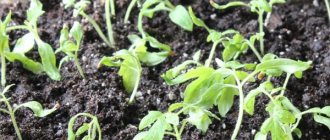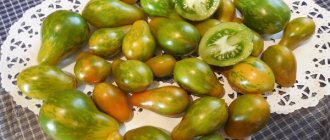Home / Vegetable garden / Tomatoes
Back
Published: September 29, 2018
Reading time: 6 min
1
4 / 5 ( 1 voice )
Tomatoes appeared in the European diet not so long ago - about 400 years ago. And before that, for almost a hundred years, the plants were considered purely ornamental, and the fruits were poisonous. The Spaniards brought tomatoes when they conquered South America.
Apparently, someone tried unripe tomatoes and got poisoned. Indeed, green tomatoes cannot be eaten raw due to the high content of the poison solanine. This led to the fact that tomato bushes were grown in gardens for beauty.
Today, more than 4,000 officially registered varieties have been bred, approximately 5,000 more are amateur selections, and the number of hybrids has already exceeded 20 thousand. Conventionally, all varieties can be divided into three groups - for open ground, for growing in greenhouses and indoor tomatoes. We will talk about the latter in detail.
- 1 Features of indoor tomatoes
- 2 What varieties of tomatoes can be grown on a windowsill in pots? 2.1 Indoor mini tomatoes of American selection
- 2.2 Dwarf varieties of domestic selection
- 4.1 The best standard varieties with guaranteed yield
What tomatoes can be grown on a windowsill?
Before growing tomatoes on the windowsill, you should decide on the variety. You can’t just choose your favorite low-growing cultivar, stick it in a pot, put it on the window, and wait for a big harvest.
Growing tomatoes at home to produce fruits should be done on a balcony or loggia in the summer. Here you can really choose a low-growing variety, take larger pots, arrange and hang them in flowerpots so that everyone has enough sun, and provide the family with vegetables for fresh consumption.
Ornamental tomatoes should be grown in an apartment. Potted varieties must have the following qualities:
- The main requirement for tomatoes for the windowsill is decorativeness.
- Bushes up to 50 cm high with very short internodes, standard. It’s even better to look for varieties up to 30 cm in size. The loss of 1-2 leaves should not affect the appearance, which is impossible to achieve with the tall growth and sparse crown of the tomato.
- Resistance to pests and diseases. It is very inconvenient to process tomatoes on the windowsill, especially in winter.
- The description of the variety must indicate that it is suitable for growing in pots. Ordinary tomatoes in open ground or a greenhouse need about 20 liters of soil for normal life. No one will put such containers on the windowsill. Balcony varieties require a minimum of 5-7 liters of soil. Real indoor tomatoes can grow in 3 liter pots, and with good regular care - 2 liters.
When purchasing tomato seeds for growing on windowsills, you need to pay attention to the manufacturer's recommendations. The minimum volume of soil mixture must be indicated on the pack. You cannot plant tomatoes in a smaller pot. They already need to be fed intensively. When placed in excessively cramped containers, the crop will have to be fertilized so often that the fruits will become an unedible decoration.
Conditions for growing nightshade at home
The plant is really unpretentious. All that is generally necessary for the growth of nightshade is moderate humidity and lighting.
In winter, during short daylight hours, it is advisable to add additional light to the plant. You can use regular light bulbs. In spring and summer there will be plenty of natural light.
Nightshade will grow in any corner of the house. The plant loves the sun very much, so the flowerpot can even be placed on a south window. But in this case, in the heat of summer, you will have to shade the flower a little from the scorching rays of the sun, otherwise the foliage will get burned.
In winter, the decorative tomato can even be moved to a glazed and insulated balcony. The plant begins a resting phase in winter, and it needs to lower the temperature to +15 degrees. Although nightshade can overwinter well in an apartment. The main thing is to remove the flowerpot away from the hot radiator.
Tomato varieties for indoor growing
It is recommended to grow early dwarf varieties of indoor tomatoes on windowsills. The height of an adult bush is the smaller the better.
Ampel varieties of tomatoes are not considered here. Hanging vines on the windowsill will not receive enough light. It is better to hang them in special baskets.
Bonsai
The variety is designed specifically for growing on windowsills. Forms a squat branched bush up to 20-30 cm high, really similar to a bonsai.
The fruits are round, red, weighing up to 25 g. They cover the plant abundantly; about 1 kg can be collected per season.
Balcony Red and Yellow F1
Tomato for planting in pots and containers. Grows well on windowsills. The bush is beautiful, up to 45 cm high.
Fruits with a rich aroma and taste can be red or yellow, weighing 15-20 g. Disadvantage - requires a pot of at least 5 liters.
Room surprise
A standard tomato that grows well on windowsills. Bush 40-50 high, with strong thick shoots.
The fruits are collected in clusters, oval, red, weighing 20-30 g, very tasty. Requires intense lighting.
Micron NK
A true dwarf with a height of 10-15 cm. Great for window sills. One of the most undemanding varieties in terms of lighting, recommended for winter cultivation.
The fruits are collected in numerous clusters and can be red or yellow. The weight of tomatoes is 10-12 g. It is impossible to eat enough from a couple of bushes, but they will decorate the interior and entertain the children.
Pinocchio
It is one of the best tomato varieties for growing on windowsills. The bush is neat, with dense beautiful foliage, up to 30 cm high.
The fruits are round, red, weighing 20 g. Can produce 1-1.5 kg of tomatoes per season.
Pygmy
The bush reaches only 30 cm. Feels good on windowsills in winter. One of the varieties that does not require light, it will produce a certain amount of fruit even in short day conditions.
Tomatoes are round, red, 25 g each.
Window Yellow
A new variety that forms a standard bush 25 cm high. Fruits profusely. Recommended for winter planting when grown on a windowsill.
Yellow tomatoes are round, weighing up to 30 g, collected in clusters.
Ruby Red
Compact variety specially created for planting in containers. The bush is no more than 50 cm high.
The tomatoes are sweet, red, weighing 20-50 g each, collected in clusters.
Teeny Tim
A Dutch variety bred specifically for fruiting on the windowsill, regardless of the time of year. The height of the bush does not exceed 30-50 cm.
The tomatoes are round, moderately sour, red, weighing 12-15 g.
Florida Petite
One of the best varieties of tomatoes that can be grown on a windowsill. The bush is 30 cm high. The fruits are collected in large clusters, red, round, quite large for a potted crop - 20-40 g each.
Recommended for growing at any time of the year; it has reduced lighting requirements.
Rules for choosing a variety
Although at first glance it may seem that growing indoor tomatoes is no more difficult than caring for house flowers, this is not so.
There are indoor varieties of cucumbers and tomatoes that can take root in flower pots
However, if you follow simple rules, starting with choosing the right variety, you can achieve a positive result. Here are some criteria for selecting your future pet:
- Your conditions and capabilities should be taken into account. As with a regular garden, desire alone is not enough. Choose varieties that can take root and bear fruit in the environment that you create for them at home.
- Not all people are able to cope with pinching and bush formation, so the variety must be standard. These tomatoes are single-stemmed and look like a small tree that does not require garter or support.
- Space is limited in flower pots, but low-growing varieties can survive in such confined conditions. Low tomatoes can produce up to 1.5-2 kg of yield per plant.
- The tomato must be hardy to withstand diseases and limited conditions (lighting, heating). Therefore, most indoor vegetables are hybrids. They are more resistant to such conditions, but are not able to maintain these qualities in subsequent generations.
You can learn about seedless tomatoes in this article.
Landing dates
If the proper conditions are created for the culture, tomatoes on the windowsill will grow all year round. You can even get a harvest by a certain date, for example, New Year, March 8, birthday. The first ripe homemade tomatoes will appear approximately 3 months after sowing the seeds. To avoid mistakes, it is better to make allowances for unfavorable conditions and add a few more days or a week.
You can calculate the date for sowing seeds yourself. If the tomatoes on the windowsill are to ripen by the New Year, they should be planted at the end of September.
Gardeners to gardeners
Spring is approaching quickly this year. Meteorologists promise + 30 degrees and above by the end of April.
In such conditions, you now need to think about what vegetables to grow in open beds, in greenhouses and greenhouses, and even... on balconies and loggias.
Not every big city resident is the happy owner of his own piece of land in the countryside. But everyone has a balcony, loggia or a large, bright window.
You can’t even imagine what kind of vegetable garden and flower garden you can create with your own hands.
Based on your numerous requests, today we will talk about what tomatoes grow on the balcony, how to care for them and which varieties are best suited for this.
WHAT TOMATOES GROW BEST ON THE BALCONY?
Before answering this question, let's limit the most important requirements for this generally unpretentious and productive crop specifically for the conditions of a small space (loggia, balcony, non-standard window with a wide window sill).
First of all, pay attention to the size of the bush. It should not exceed 60 cm in height, otherwise the plants will be cramped.
Determinate varieties with limited growth are suitable for this. In addition, they will not need to be pinched, which will make care much easier.
An equally important factor is the ripening period. Choose only early ripening varieties (ripening 65 - 100 days).
Few lovers of balcony tomatoes grow them to obtain record yields: they simply do not have enough space for this. But providing yourself with fresh fruits for daily consumption during the summer is quite possible.
Therefore, when choosing varieties, we recommend that you pay attention first of all to cherry and low-growing determinate varieties.
We have already talked in detail about how to grow tomatoes in a greenhouse and open ground in our articles:
“How to grow tomatoes”, “How to care for tomatoes”, “The best varieties of tomatoes for open ground”.
In this article we will tell you in detail about the agricultural technology of growing tomatoes on the balcony, as it has many subtleties that you need to know about.
In addition, we will advise you on the best varieties and hybrids from our collection, designed specifically for balcony growing.
WHEN TO SOW SEEDS AND WHEN TO PLANT BALCONY TOMATO SEEDLINGS
To get the first tomato harvest at the end of June, seeds for seedlings should be planted in late February - early March. Tomato seedlings for any planting are grown the same way.
We have already written about this in detail in our article: “Caring for tomato seedlings.”
In this article we will tell you which tomatoes grow best on the balcony.
Tomatoes are quite unpretentious, but in order for them to feel good and their seedlings to grow and develop normally, they need to create comfortable conditions for this: a constant temperature of +20...+ 22 degrees. humidity 60%, good light, frequent watering, adequate nutrition and regular pollination.
The seedlings are transplanted to a permanent place on the balcony (or loggia) in the phase of 6 true leaves. This usually happens in mid-April. If the tomatoes grew in single containers (peat cups or pots), then they are simply transplanted into larger containers.
If you grew seedlings in a box, then you will also have to pick them (planting plants from a common cramped container into large single ones).
When picking, wet the box with seedlings well with water, then carefully pull out each plant with a small lump of earth, grasping the very bottom of the stem.
Carefully cut the spine to a quarter of its length. Use a stick to make a hole in the new container, into which place each plant up to the cotyledon leaves, leaving part of the stem in the ground. New roots form on it very quickly, which will quickly help the plant take root.
It is better to use purchased soil for growing vegetables, adding perlite and vermicompost to it in accordance with the recommendations indicated on the packages.
After planting, compact the soil around the plants and water all the bushes very well.
Large flower pots or tubs (for example, for palm trees), plastic buckets and deep basins, and wooden boxes can be used as planting containers. Naturally, they all must have drainage holes to drain excess water and appropriate trays.
It is clear that this article deals only with glazed balconies and loggias.
After transplanting the seedlings, the balcony windows need to be shaded with white sheets or paper for a couple of days. Maintain the temperature: during the day – + 20, at night – + 18 degrees.
To do this, keep the doors to your apartment open at all times. If necessary, turn on some kind of heater. Monitor the temperature carefully to avoid overheating the plants. It should not exceed + 26 degrees!
HOW TO CARE FOR TOMATOES THAT GROW ON THE BALCONY
Watering . Experienced gardeners like to repeat: “A tomato should keep its feet in water and its head dry.”
Humid air on the balcony is contraindicated for tomatoes. It can provoke the development of late blight, especially if the window frames on the loggia are wooden.
Therefore, water the plants at the roots and at the same time make sure that drops of water do not fall on the leaves, flowers and fruits.
Since the volume of soil around the root system is limited, water more often. The soil should always be loose and moist. We do not recommend using tap water for irrigation. It is better to bring a bucket from the nearest body of water for swimming (pond, river) or prepare melted snow if there is a lot of clean snow nearby.
Fertilizer. 2 days after planting, the seedlings are fed with a solution of some kind of root-forming drug (“Zircon”, “Kornevin” or “Heteroauxin”). This will contribute to the rapid growth of roots and the growth of the bush itself.
Two weeks after this, feed the seedlings with some ready-made mineral complex for spring feeding of vegetables. Apply the second and third feedings with the same complex at intervals of 10 days.
Loosening. It must be carried out regularly after each watering and application of liquid fertilizers so that a soil crust does not form on the surface. In addition, loosening helps improve air exchange in the root layer, which is so important for the proper growth and development of plants.
Pollination . This is one of the most important operations, especially if you live in the city center, where there are practically no pollinating insects.
Tomatoes that grow on the balcony are pollinated using a brush, a fan, or regular tapping on the flowering brushes of the plant. This technique creates a vibration that causes pollen to fall off and land on other flowers.
If you live in a green area, place saucers with sugar syrup or old jam on your balcony windowsills. They will attract pollinating insects to your plants.
Stepsonning . Not all varieties need it. Determinate ones themselves form several brushes and stop growing. The cherry and cocktail tomatoes that we offer you don’t need to be pinched either.
WHAT VARIETIES AND HYBRIDS GROW WELL ON THE BALCONY
Now that you know which tomatoes grow best on the balcony, we offer you the best varieties and hybrids from our collection. They are very unpretentious, incredibly tasty, early ripening, productive and disease resistant.
Determinate varieties and hybrids:
Pink Katya F1, Simon F1, Prokhor F1, Burlak F1, Zephyr F1, Manzherok F1, Vasily F1, Zastolny, Apricot F1, Duchess, Champion F1, Son of a Hero F1, My Love F1, Timofey F1, Ercole F1, Metelitsa F1, Duckling .
Our series (from determinate varieties):
Episode 1 – Raspberry Sunset, Raspberry Berry, Bright Robin, Raspberry Paradise, Raspberry Wine.
Episode 2 – Raspberry Joy, Raspberry Bison, Raspberry Dream, Raspberry KingxDEU, Raspberry Desirable.
Episode 3 – Raspberry popsicle, Raspberry heart, Raspberry bunny, Raspberry hero, Raspberry surprise.
Cherry tomato varieties and hybrids:
Verige F1, Cherrinano F1, Cherry F1, Children's, Cherry Ira F1, Cherriquira F1.
You can buy all these varieties from us today!
Preparation of seeds and soil mixture
Coated tomato seeds for growing on windowsills are planted dry. With the rest, the gardener can carry out all the operations he wants, fortunately, few plants are needed. Strictly speaking, they only need short-term heating, pickling and soaking until they swell. Old tomato seeds should be checked for germination.
It is better not to use planting material of unknown origin at all. Tomatoes can be tall, it’s a shame to throw them away, and keeping them at home is problematic.
To grow tomatoes on a windowsill and not have to bother with preparing the soil mixture, use purchased soil for seedlings based on peat. It needs to be placed in a bucket directly in the bag, pour boiling water over it, cover with a lid and allow to cool naturally.
Those who like to prepare the soil themselves can use one of the recipes:
- sand and garden soil (1:2);
- humus, neutral (black) peat, turf soil (1:1:1);
- turf soil, humus (compost), vermiculite (perlite) - in a ratio of 4:4:1;
- garden soil, humus, sand, peat (5:5:2:1).
Whatever components are used when preparing the soil mixture yourself, they must first be disinfected in any convenient way: poured with potassium permanganate, steamed, calcined in the oven. It is prohibited to take soil from a garden bed where tomatoes were previously grown.
You cannot reuse a substrate with vermiculite even after careful treatment. When exposed to moisture, it begins to decompose after 6 months.
Preparing the soil for planting indoor tomatoes
These crops prefer soil mixed with humus, and the consistency should remain permeable and moist. The composition of the mixture looks like this:
- meadow or forest land - 5 parts;
- compost (rotted) - 5 parts;
- sand - 2 parts;
- peat - 1 part.
Important! Soil from a garden or forest should be used only after thorough disinfection.
Growing tomatoes on a windowsill in winter occurs in limited conditions, so it is recommended to ensure that the plant receives the maximum amount of nutrients. This can be done by applying a complex of fertilizers. For a bucket of soil: a handful of wood ash, 10 g of urea, 40 g of superphosphate and 40 g of potassium fertilizer.
How to plant seeds
First you need to take care of the lighting. It may be required not only in winter or early spring. It all depends on the amount of light received by the plants grown on the windowsill. In some houses it is necessary to install lamps even in the summer, otherwise indoor tomatoes will stretch out, become ugly, and simply will not produce a harvest.
It is better to plant tomato seeds for growing on a windowsill immediately in individual containers. You can use special pallets, plastic or peat cups.
The process of planting and growing before moving to permanent containers step by step:
- If the container does not have lower holes for water drainage, they are made first. It is convenient to use a hot nail.
- Plastic glasses or pallets are filled with wet substrate. Cups are filled approximately 1/3 full. Lightly compact the substrate.
- 2-3 seeds are planted in each container to a depth of 5-10 mm.
- Moisten with a household spray bottle.
- Cover with glass or transparent cellophane.
- Keep at a temperature of about 25° C.
- Ventilate the container daily, remove condensation, and check the humidity.
- When seedlings appear, they are moved for a week to a bright place with a temperature of about 16 ° C. Tomatoes from seeds grown on a windowsill should not stretch. And this cannot be avoided even with dwarf varieties without reducing the temperature at the initial stage of development and good lighting.
- Then the seedlings are kept on window sills at a temperature of about 20° C. They are illuminated for up to 12 hours a day.
- When 2 true leaves appear, choose 1 strongest sprout. The rest are cut or plucked. You cannot leave 2 plants or more in a container - the feeding area is already limited.
- Tomatoes planted in deep glasses are sprinkled with a moist substrate up to the cotyledon leaves about once every 10 days.
- When 3-4 true leaves appear, the first feeding is given. It is better to use a special fertilizer for tomatoes. There, all the elements necessary for culture are given in correctly selected proportions. A few extra rubles spent on specialized feeding will save you from many problems in the future and make care easier. The concentration of the working solution should be as specified in the instructions for seedlings.
- Every 10 days, it is recommended to treat a leaf with a solution of humate + alternately epin and zircon. You can add a chelate complex or a half dose of a mineral fertilizer that is highly soluble in water to the spraying mixture.
- After 2 months, the tomatoes are transferred to large pots. They are carefully removed from the intermediate containers, trying not to destroy the earthen lump.
It is recommended to plant indoor tomatoes in plastic containers with a capacity of 3 liters.
Unfired clay pots also work well. If they look unsightly or do not match the interior, use beautiful flowerpots to disguise them.
Reproduction methods
There are two commonly used methods of propagating nightshade, the first is by seeds and the second is by cuttings.
Propagation by seeds
To plant seeds, you need to prepare a container and suitable sifted soil, and after that the seeds are laid out on the surface of the soil. Next, the surface is crushed with sand, slightly moistened and covered with film. The container with seeds and cover is hidden in a warm place (+22-+23). Within 2-3 weeks, shoots should appear, which, as they grow, will need to be pricked twice, and only after that the plant is ready for planting in the soil.
Propagation by cuttings
Another propagation option is stem cuttings. After spring pruning, the cut branches are not thrown away, but are planted in a mixture of soil and peat, and after rooting they can be transplanted into a separate pot. In the container for transplantation, the bottom layer must be drainage.
Caring for tomatoes in pots
Caring for tomatoes when grown on windowsills is not so difficult. If the soil mixture has been disinfected, and indoor flowers are kept at some distance, the crop will escape most of the diseases and pests that plague it in open ground and greenhouses.
Tomatoes located on window sills have much fewer problems than when grown on balconies and in hanging baskets near the house.
Care is as follows:
- regular watering;
- loosening the substrate 1-2 weeks after transplantation;
- feeding;
- removing the lower leaves if they lie on the ground;
- additional lighting up to 12-16 hours a day, and consecutively - the plant should also rest;
- harvesting.
To maintain decorativeness, you can remove a leaf or stepson that is “out of order,” but you should not be too zealous.
Preventative treatments for tomatoes on the windowsill are usually not needed. But if there are infected indoor plants in the house, or the planting was carried out in a substrate prepared independently, you will have to use both fungicides and insecticides in the dosage indicated on the package.
There is no need to pollinate tomatoes with cotton swabs. It is enough to shake the bushes several times during flowering.
Temperature
Optimally, you should try to ensure that the average temperature in the spring and summer is a minimum of 18 degrees and a maximum of 26. In winter, the temperature should be reduced to 12-14, otherwise a side effect is possible - falling of fruits and leaves. This plant reacts very negatively to drafts; it is better to avoid them.
We determine what does not suit nightshade by appearance:
If your nightshade begins to get sick, turn yellow or drop leaves, the conditions are not suitable for emu. Examine the plant carefully, because by its appearance you can easily understand what the problem is. For example, if there is not enough light, then the nightshade will shed its leaves; if there is not enough heat, then the result is poor flowering and small fruits, but curling leaves indicate an excess of sunlight.
Protecting tomatoes from diseases
Another point that is worth paying attention to is the protection of tomatoes in pots from diseases, because even room conditions cannot guarantee their complete absence. One of the main enemies of nightshades is late blight. To prevent its manifestation, it is important not to flood the bushes and drain the water from the pan. The fungus also does not tolerate fresh air, so you need to ventilate the room more often.
As a preventive measure, you can spray your plants with a homemade remedy made from the following ingredients:
- 3 liters of water;
- 100 g garlic (chopped);
- 1 g of dry crystals of potassium permanganate.











